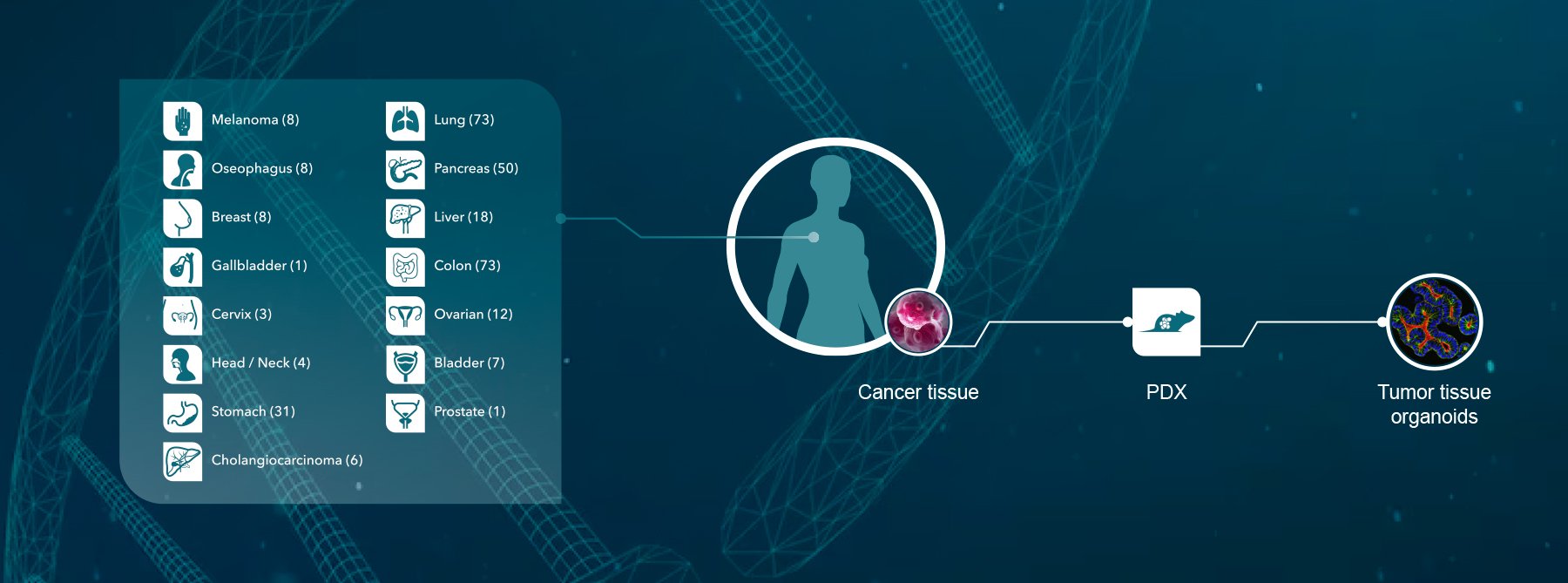 In this post we explore how using a range of translational preclinical models can be used to accelerate the discovery and validation of predictive biomarkers, with the goal of de-risking drug development to increase the likelihood of clinical success for therapeutic candidates.
In this post we explore how using a range of translational preclinical models can be used to accelerate the discovery and validation of predictive biomarkers, with the goal of de-risking drug development to increase the likelihood of clinical success for therapeutic candidates.
Why Develop a Preclinical Biomarker Strategy?
Biomarkers are playing an increasingly important role in improving the translational power of preclinical studies. While the value proposition for incorporating clinical biomarkers is clear, it is important that biomarker strategies are incorporated as early as possible in drug development. This is because it will provide the best opportunity for discovering optimal biomarkers and ample time to fully validate them preclinically, using both in vivo and in vitro experimental systems, to ensure they are sensitive, specific, and reproducible in their intended use.
In our experience, the discovery of a biomarker with clinical utility is highly feasible at the earliest stages of development, and the key factors for success are:
- Commitment to biomarker discovery and validation at an early stage
- Access to a wide number/range of in vitro and in vivo models with available molecular characterization and that replicate clinical diversity observed in patient populations
- Appropriate selection of preclinical in vivo models based on molecular data and/or a biomarker hypothesis generated using in vitro data.
Deploying a systems biology approach is key for the early identification of robust and sensitive biomarkers that can later guide the selection of the most promising investigational agents at an early stage while tailoring novel therapeutics for specific patient populations and disease indications.
Leveraging a Systems Biology Platform Approach for Biomarker Discovery and Validation
Adopting a systems biology approach to understanding biological mechanisms—such as integrating molecular and cellular information across the spectrum of preclinical assays, including in silico, in vitro, ex vivo, and in vivo models—maximizes the chances of discovering novel and relevant biomarkers. These biomarkers can be used to monitor disease, drug response, toxicology, and target engagement in relevant models. The translatability of preclinical biomarkers is bolstered when tested and validated in large and annotated portfolios of well-characterized in vitro and in vivo models designed to capture the diversity that exists in real-world patient populations.
A typical biomarker discovery workflow using a systems biology approach begins by obtaining baseline genomic and/or proteomic profiles of an in vitro model, treating the model with an investigational agent, and then analyzing and comparing the “-omics” profiles of responder versus non-responder samples. These data can then be used to guide the selection of well-characterized portfolios of highly relevant in vitro models (e.g., tumor organoids) and in vivo models for additional testing and validation of these initial data. This type of comprehensive approach can reduce costs and accelerate timelines, while opening new opportunities to evaluate differences in drug response based on stratification by biomarker.
Advancing Biomarker Discovery and Validation: Assays and Bioinformatics
The following section provides an overview of assays that can be used to analyze biomarkers, as well as the value of incorporating bioinformatic analyses into a preclinical biomaker program.
Biomarker analysis
A variety of assays are routinely used for studying biomarkers, including the following:
- Flow cytometry for cell functionality and phenotyping and biomarker expression,
- Meso Scale Discovery Electrochemiluminescence (MSD-ECL) and ELISA-based cytokine and chemokine profiling,
- Imaging-based rare cell analysis to track cells that express biomarkers of response,
- Histology and digital pathology for biomarker detection and spatial expression,
- Clinical chemistry for drug efficacy and mechanism of action (MOA) assessments,
- Mass spectrometry-based proteomic analyses,
- Genomic analyses.
Incorporating genomics into the biomarker discovery and analysis workflow can accelerate drug development. Methods such as RNASeq, PCR, and next-generation sequencing (NGS) provide detailed genomic and transcriptomic insights on the complexity of disease, tumor drug response, drug MOA, and novel biomarkers, such as gene mutations and changes in tumor gene expression, that correlate with drug response or resistance. These assays are amenable to high throughput approaches for large scale preclinical studies that need to evaluate large numbers of genomic biomarkers in parallel.
Conducting biomarker analyses at the end of an in vivo or in vitro efficacy study can be used for validation purposes including target correlation with mechanism of action (MOA) of the drug and allows the predictive value (i.e., response or non-response) of an investigational agent to be determined. The results of this type of analysis can form the foundation for determining the inclusion/exclusion patient-selection criteria for future clinical studies.
Bioinformatic analysis
In silico analyses are increasingly being used to make use of the vast amounts of information housed in genomic and pharmacology datasets. For example, bioinformatics and AI/machine learning algorithms can support hypothesis-free predictive biomarker discovery approaches that can be used to discover target patient populations without knowledge of a drug’s MOA.
Bioinformatics can also be used to support biomarker discovery by analyzing data downstream of large-scale in vitro cells screening assays (using cell lines or more advanced tumor organoids that have baseline genomic information available) to provide early indications of responder and non-responder cell lines based on genomic patterns. By integrating the results of cell screening assays with bioinformatics, pharmacological responses can be correlated with genomic information (gene expression, mutation status, copy number, pathway/network information) that can provide multiple readouts to enhance biomarker identification. In vitro data can then be used to inform in vivo studies for more robust functional and mechanistic studies on biomarkers with the most potential. Indeed, bioinformatic analyses can be used to inform the selection of xenograft models and patient-derived xenograft (PDX) models based on a drug’s target or mutation pattern.
An Integrated Approach as the Fuel for Mouse Clinical Trials
By funnelling drug candidates through in silico, in vitro, and in vivo models in systematic way, optimal biomarker targets and preclinical models can be selected. For example, mouse immuno-oncology RNA-Seq-derived panel can be used for large scale discovery applications, while flow cytometry and immunohistochemistry applications can be used when a smaller subset of possible biomarkers need to be tested at the cellular level. This approach is particularly relevant given recent the rise of immune checkpoint inhibitors and the importance of various immune cell populations on drug efficacy. The combined use of genomic and proteomic information also provides researchers with the opportunity to establish the MOA of their therapeutic candidate.
Subsequently, Mouse clinical trials (MCTs), which serve as a surrogate for human clinical trials, can be used since make use of multiple PDX models for evaluating drug response and correlations with genomic features. When combined with advanced statistical frameworks, MCTs are highly capable of identifying biomarkers that improve patient stratification, and in some cases, can rescue agents that failed human trials. For example, linear mixed model analysis identified EGFR as a top gene in predicting Cetuximab response in gastric PDX models. In addition, a panel of clinically relevant colorectal cancer (PDX) models led to the identification of KRAS mutations and GSTT1 expression in mediating response to standard of care FOLFOX treatment.
Which Assays Should I Select?
Choosing the most appropriate assays and models for your preclinical studies can be challenging given the increasing number of available options. Before starting a biomarker study, researchers should consider the following:
- What does the assay measure?
- What are the benefits of the assay over alternatives?
- Is the assay suitable for discovery or screening?
- Is the assay amenable to a high-throughput approach?
- Does the assay complement other assays for the same study?
We highly suggest engaging early with experts that have deep experience in conducting preclinical studies for biomarker discovery and validation since they can help you navigate the best course for your specific research needs and circumvent common pitfalls.
Conclusion
Discovering preclinical biomarkers with clinical utility is highly feasible when a biomarker strategy is established early in development. Further, using a systems biology and integrated platform approach for biomarker discovery and validation, provides the best opportunity for identifying the most promising biomarker candidates early, which can subsequently inform downstream in vivo preclinical model selection.









